
|   |

|   |
 e-mail: leelakaverivenkat@gmail.com Interface of Sthiti Gati polarities Photos: Yoga January 14, 2017 Being anchored in core principles, while changing unconsciously or deliberately, moving through the corridor of time, has been the history of Bharatanatyam - as of many other traditional disciplines. Built round the theme Sthiti Gati, the 36th Natya Kala Conference mounted by Yagnaraman Centre for Performing Arts and Sri Krishna Gana Sabha brought out these complementing polarities of the Constant and the Changing. Amidst a host of high profile dancers who have conducted this event, this year's Srinidhi Chidambaram earned a hearty vote of approval for her meticulously planned calendar of events each day, (worked out with Aalaap as creative collaborator - design, name of the conference and event coordination) giving equal opportunity for all shades of expression, her own neatly worked out introductions for artists /events to the point, flattering without gush. Politely firm on adherence to time specifications, she maintained an underplayed presence without hogging performance space or thrusting her opinions on anyone - her greatest achievement being in painstakingly contacting persons running dance institutions through volunteers, ensuring a near full auditorium every day, with several young minds instead of the handful of middle aged and senior faithfuls in attendance every day. The curtain raiser was Lakshmi Viswanathan's brilliant talk of a broad sweep of history on the 'Dancer through the Ages,' with special reference to the Tamil speaking regions, wherein the Kootu performed by male dancers was overwhelmed in time with the female dancers like Madhavi the 'sakala kala valli' heroine of Silappadikaram. Following the trained courtesans and Rudraganikas were the Devadasis as the high priestesses of dance serving the deity in the temple, with Tevaram hymns sung and danced. The speaker's account was dotted with anecdotes built round temple dancers like Paravai Nacchiyar serving the god Sundaramurthy Nayanar. Lakshmi mentioned the 'nandavilakku' (eternal lamps lit for the god) donated by these women of high learning and art expertise. Anecdotes like the temple chariot coming to a grinding halt, till pulled by the hand of a devadasi setting it in motion again, dotted the talk pointing out how auspicious these women were. Then came the dance in the royal courts like that of Vijayaraghava Nayak, and of the Marathas during whose time Pallakka seva prabandham was introduced. The pre Bala devadasis who by that time were settled in George Town Madras were even associated with the Freedom Movement. The roundup ended with a reference to the pathetic disenfranchisement of the devadasi with attempts by the like of E. Krishna Iyer to save the art from going into oblivion. Bharatanatyam in the international arena 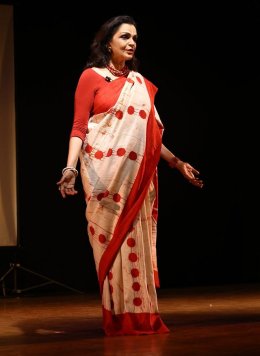 Anita Ratnam With her constant travels round the world, "Solo Bharatanatyam is boring" for the New Yorker, announced Anita Ratnam in her usual dramatic style speaking on 'Emerging Trends in Performance and Presentation.' Pleading for a state of the art performance space for the Performing Arts, she also advocated building up a core of people with the right concerns for the performance situation to improve. Since this year's audience for Margazhi Season comprised 80 percent from outside and 20 from inside, it was time in this 360 degrees perspective to become more aware of how to treat artistic activity which should be at that level of engagement attracting people to the auditorium to watch dance. Time to get rid of 'smugness', she called the tenth rasa. Creating an eco system of dance enthusiasts was necessary with a dramaturg to provide inputs making dance more sophisticated -providing that glue which is needed. Answers were needed for how all the Akademis with unaccounted for GDP carried on year after year doing little for the arts. Did it matter what New York thought of Bharatanatyam? Priyadarsini Govind asked, representing the other view point in an exchange with Gowri Ramnarayan. The best brains in the world in every field came to Kalakshetra to interact with the students. What she had realized in Kalakshetra in her years as Director was that Rukmini Devi had built a space with a feel for beauty and integrity as very essential parts of all art to be inculcated in growing minds as part of their character. Truth and dedication lay in every act from the Kolam designs drawn on the earth early morning, to those moments of group prayer under the banyan tree, with the chirping birds and moving squirrels in tow - to the Bharatanatyam and music classes. No institution could replicate Kalakshetra. As for wishes expressed of a state of the art auditorium, there was one waiting for rebuilding in Kalakshetra itself. Why not enthusiasts come forward to enable rebuilding (with all the state of the art fittings) the auditorium? Rukmini Devi sarees in their original colours, with the weaving section revived and in full throttle, were to be brought back. Oral documentation to bring about unity in teaching, life skills through art and providing suitable mentorship were all part of the new programs worked out with the Ministry of Culture. For Gowri Ramnarayan, her own young days spent in Kalakshetra, where the greatest names in music and dance taught the next generation with humility and compassion, characterized the institution Rukmini Devi had built, where great minds gave themselves to a shared vision. There was the generosity to accept all around you. And Kalakshetra was no Robinson Crusoe island - people like the Tibetan refugees, during the crisis, were provided shelter there. The relationship in Besant Arundale School amongst teachers and students was one of freedom with discipline. Gowri recollected an incident when she and a companion climbed a tree only to find that they were not able to come down. The headmaster taking in the situation calmly said that he would help get them down when the gardener came and in the meanwhile he told the teacher to conduct the class under the tree! The one and two minute clips from Rukmini Devi's Ramayana series of Hanuman's entry, the Setu Bandhan scene and one of the Apsaras recounting the Ravana/Rama battle proved too fleeting to make any impression. "Choreography? I had never heard this word before," said Aniruddha Knight. For him traditional Bharatanatyam of his grandmother Bala and mother Lakshmi was largely improvisational interpretation of the musical line, barring the structured essence of its nritta in the jatis, with no such thing as choreography. 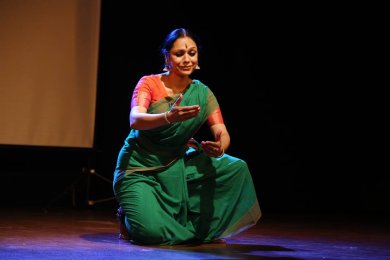 Rama Vaidyanathan But that there can be space for designing Bharatanatyam presentation for today was seen in RamaVaidyanathan's work where communication with a north Indian audience had made her compose dance using the textual format of verses of Janabai or even Meerabai's songs presented in a varnam format. "Jhuk aeere badariyan sawan ki man bhaavan ki" was presented along with daughter Dakshina. A Pandaattam scene through a Jati visualized as interaction between two people, with some imaginative music, was enjoyed by the audience - and did not hurt classical virtues - though a view was expressed that it was a distraction not adding to the statement being made in the item. Another item based on Sangam verses (the verses portraying the mother / daughter relationship as relevant today as then) portrayed the mother who having led the daughter through childhood and teens is reluctant to let go her control over the now teenaged girl who has eloped with a young man. And what poetic imagery in the verses advising the possessive mother, that just as the pearl is no good to the oyster till separated from its birth shell, the sandalwood fragrance felt only from products made from wood cut from the tree, and notes doing little for the instrument or listeners till played by a musician, the umbilical cord has to be cut at some stage. 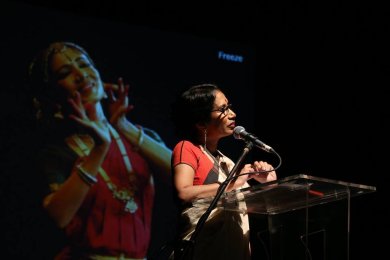 Alarmel Valli Talking of poetic quality and musicality (as opposed to Poetry and Music) was Alarmel Valli's very sensitive talk on the world of resonance or dhwani where a performer who is not a virtuoso, can create visual music through movement. She quoted George Balanchine that kinetic arrangements of static syllables is poetry. Thus music can be seen and dance heard - as when Jayamma sang and Balamma danced and one could not separate dance from the music. Music can evoke visual images and movement can create metaphorically heard music. For that matter even talam in its accents and unaccented fractions creates music. Through the subtle voice of resonance one becomes sensitized to, through years of absorbing poetry, one finds one's individual voice in natya. The clip on the Kshetrayya padam "Paiyyada.." full of emotional resonance in Bombay Jayashree's singing, with the dancer's abhinaya throbbing with the sound of desolation, very evocative for most in the audience, had reckoned without that scholar V.A.K Ranga Rao, who like a bloodhound will smell out the smallest of sahitya blemishes. He promptly observed "She has used the wrong text" referring to the opening line. Taking the stage for just seven minutes next morning V.A.K. Ranga Rao spoke of his 'nitpicking' which was to ensure that the poet's text is faithfully followed. He recounted to this writer privately how he had pointed out to Muktamma her fault in the first line showing her the Kshetrayya documents for proof. For him the language of the poet under no circumstances could be tampered with. While he respected Muktamma as the greatest authority in Padam and Javali singing, the sahitya belonged to the poet and he alone was the last and only authority- and Muktamma had instructed that the sahitya be changed, without of course changing a note in her music. Those were the days 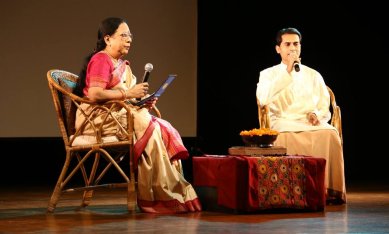 Nandini Ramani & Swamimalai Suresh While Nandini Ramani fluently, nostalgically recalled her days under Kandappa Pillai (who alone taught nritta with Bala coming in only at the later abhinaya stage), she and Swamimalai Suresh whose 'Gurukulavasam' was under Swamimalai Rajaratnam Pillai, shared their respective experiences in mastering the intricacies of a teermanam, the sollus and their arrangements and jati conventions - in the Tanjavur and Vazhuvoor schools. While Nandini recollected the rigors of having to do a complicated teermanam with 'eduppu' or starting point at fractional points of the tala concluding on the dot of 'sama' in the seated ardhamandala position. ("Try and do it," she threw a challenge), Swamimalai Suresh spoke of the nattuvangam and wielding the cymbals - a whole discipline in itself which posed intricacies in its articulated and unarticulated fractions. "Gurus never told us anything. Bala while making fun of me 'where are those eyes looking' would never tell me where they had to look." All traditional gurus like Kittappa Pillai and Chokkalingam Pillai would just give the basics and ask the student to fill in the details through her own creative imagination. Music and Dance went together was the refrain. Even while adapting a Bharatiyar song or even a folk song and setting it for Bharatanatyam interpretation, how Rajaratnam Pillai set the music and tala at a more deliberate pace, with accented points in sahityam and tala suitable for natya visualization, was fleetingly demonstrated. As usual, nostalgia was expressed for 'those great days' when dance and music moved totally in step. The point remains that having moved away from those days, in these times to get, for whatever remains of 'Banis' (paramparas), singers who specialize in the special style of singing for that school, is a pipe dream. With such widespread aspirants for Bharatanatyam from all over, many of whom, at times, with only a nodding acquaintance with Carnatic music, Bharatanatyam and its music live in a wide level of relationships. With no change in sight, let us stop tilting at windmills some would say. And as Meenakshi Srinivasan cautioned during a panel discussion, the argument of everything new being sub standard (or old being wonderful) would be wrong. That Bharatanatyam does not and cannot live in cuckoo land and that compulsions of interacting with other dance forms and western sensibilities, while being grounded in the principles of Bharatanatyam, are being treated as opportunities for creation even by conservative gurus like V.P. Dhananjayan, was seen in examples of productions like 'Jungle Book' where Bharatanatyam shared the stage with Ballet dancers of Ohio Ballet group. "Text is minimized and angikabhinaya is stressed." After working out the dance movements, the music was done by Vijayaraghava Rao and even ballet dancers performed to Indian music. Dhananjayans, through excerpts from his many group compositions showed finely trained group dancers epitomizing the qualities he considered necessary of Discipline/Devotion/Dedication. 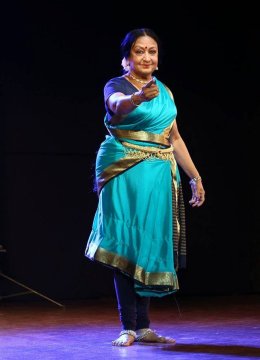 Padma Subrahmanyam Padma Subrahmanyam delving into the Natya Sastra had realized how theory and practice had grown apart. How could the temple sculpture in the south, so clearly etch poses and verses from the Natya Sastra while the dance practice which evolved here with adavus as building blocks, have no Natya Sastra karanas? She brought in the thematic solo in works like 'Krishnaya tubhyam namah' before she got to learn about the dasharoopakas and the 'ekaharta' treatment in Nirupanas of the Maratha Raja where a set of 18 items were set in just one raga. Created in 1973, the work does not lose its newness through several repetitions because what Padma does is "not to act but to react"- which is ever fresh. Then she tried the multilingual treatment in 'Ramaya tubhyam' where she brought into one theme poetry by poets in Malayalam, in Tamil and in Hindi. Finally she tried abstract themes like 'Jaya Jaya Shankara' and advaita philosophy with practitioners like Dayanand Saraswati himself helping her out. Her words for youngsters were based on just three main points 1)learn to appreciate 2) keenly observe life around. Ultimately the technique must give the performer wings to fly -leading to enlightenment. Just as water finds its level, the dancer will find her audience. While the panel of singers for dance like S. Rajeswari, Madurai R. Muralidharan, Radha Badri, discussed music, one appreciated Radha Badri's golden words about singing for arangetrams requiring restraint from the musician to stick to the number of sangatis for each line as specified by the teacher. Anything away from this would confuse the youngsters and put them off. Also be available for as many rehearsals as needed. When in doubt about text or the music, meet the composer (or a well known master) and get the right details from them. Similarly, wise counsel from Nellai Kannan was that the mridangist should play for the dance watching the feet of the dancer. The nadai should clearly emerge in the percussion playing. Arithmetic is a different concern. He spoke of the very crisp short jatis of old - which brought out all aspects with great clarity and created an impact earning applause too. He advocated playing for Bhajan sessions and for Kathakalakshepams as a great learning process for a percussionist. Rajkumar Bharati, 'the gentle giant,' felt that knowledge of the Navarasas and of poetry was must for the music composer. Bharatanatyam teaching as discussed by young performing teachers with Urmila Satyanarayanan moderating the session, touched on how to wear two caps at the same time. Parents eagerly pushing for a stage debut for their child, was not entirely a recent phenomenon for as one person remarked even the old gurus worked to a specific time frame within which the disciple had to be taught a margam. All young teachers admitted to using technological tools to make working easy, though all agreed that a total dependence on this (with videos flooding the market) without the live teacher/student exchange was ill advised- Madurai Muralidharan complained that video sellers made money without compensating the composer! A separate panel discussion was needed on what group dancing (which all teachers today are working with) involves as against classical solo without being reduced to becoming just a multiplicity of solo dancers. Dancers stealthily switch gurus quite often. Bragha Bessell mentioned her guru Adyar Lakshman's cardinal advice, "It becomes an insult when the student leaves without informing the guru. Inform the guru and take leave." This keeps the pride of the guru intact. To follow the legacy of the guru exactly is not everybody's motto. As dancer / choreographer / film actor Shobana said, "Teacher equipped me to move - and I moved on." As examples of her work she talked of her treatment of a tillana, making it more dense by fitting in complicated rhythm patterns whereas the example of the tillana in Kamas, with the unarticulated spaces in between from 1 to 8 counts showed her incisive feel for laya. And she brought out the changes between how the film and dance vary. In film the editor's scissors can create a whole new effect! 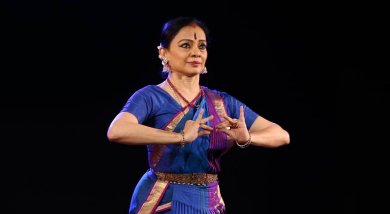 Malavika Sarukkai Malavika Sarukkai spoke about the body in dance and how dance creates deeper awareness if practiced as a sadhana. For her after the meditative rigor of bhakti in dance, the "I, me, courtesan" preoccupied with one's own body, in visualizing seduction, was very easy. Presenting an excerpt from Yudhisthira's dream, with the deer appealing to the King to save animals, she spoke of the abstraction of 'deerness', and 'treeness' - and the need to enter into another consciousness while representing characters like these. Hanuman is another example, which creates a displacement of the self and makes your persona non-existent. This was a very important and difficult point to discuss, but paucity of time in a twenty minute slot did not permit it. The body as an instrument, sharp with awareness and mindfulness has always involved Malavika's thinking. Prone to injuries and health problems due to overuse of certain parts of the body like knee joints, the back, the feet, dancers need constant supervision for preserving core matters of health said obstetrician, gynecologist and fitness and lifestyle consultant Dr. Sheela Nambiar. Contrary to popular opinion, constant dancing becomes a part of body activity and does not prevent growth of fat. For keeping weight on leash, diet with high protein and calorie intake can help gain muscle and not weight. Strengthening muscles round the area of the ankles and knees and thighs with a routine fitness schedule (which offsets the overuse of certain parts of the body and less use (stomach) of certain other parts in Bharatanatyam) alongside the dance practice is a must. Very necessary for Bharatanatyam practitioners who after years of dancing generally develop too much weight round the hips! Dancers often tend to lack a sense of humour. It is no surprise that serious 'hasya' is not such a large part of the repertoire in Bharatanatyam! What a wonderful idea to get a person like Revathi Sankkaran to talk on the dance/dancer on the screen. With screening of film excerpts, her imitations with narrative kept one in splits, almost falling off the chair in laughter. She provided that feel for the lighter side of life as nothing else did. Along with this was the observation that one owed much to the film producers for creating a feel for aesthetics in dance on film with nattuvanars like Vazhuvoor and Kuchipudi gurus like Vempati Chinna Satyam and dancers like Muthukumara Pillai's students, and latter Padmini/Ragini/Lalita and Vyjayantimala Bali as dancers joining the film world. 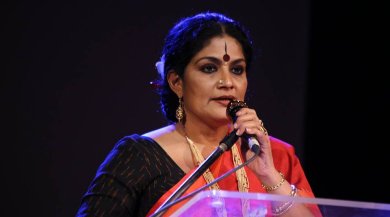 Geeta Chandran "Economics of the Classical," a talk by Geeta Chandran (she affirmed "I have gained no advantage from this patronage system in Tamilnadu and I can afford to speak in all frankness") in its forthright tone had everyone in the auditorium wanting to ask queries at the end. Geeta agreed that dancers, each in one's own way, did manage to find a living for themselves through teaching mainly and performing whenever possible despite the poor compensation .The Sabha culture with the dancer/sabha interaction, a love/hate relationship, if unkind to the dancer, is the fault of both agencies, especially the dancer for agreeing to pay for spaces to dance, instead of insisting on payment for dance. One can talk till the cows come home, but talking about this point frequently has not changed anything. To develop a climate of art consciousness, and to disconnect dance training in institutions from performances only - thinking of it in connection with other areas of activity like writing, like scholarship, like treating handicapped people etc was the need of the hour. And to form consortiums offering help for events - where the dancer gets properly paid for her work is the need of the hour. Asked about institutions running on generous government funds, she said that these, along with the corporate sector had a duty towards society in helping the cause of art. Stage designing, conspicuous by its absence in most sabhas, had a speaker in V.V. Ramani. The art of stage decor in India has to be managed with negligible funding. In such a climate any achievements had to be lauded. Documentation with the printed colourful booklet Sthiti Gati is well designed, and informative. In conclusion a successful interaction on Bharatanatyam!  Writing on the dance scene for the last forty years, Leela Venkataraman's incisive comments on performances of all dance forms, participation in dance discussions both in India and abroad, and as a regular contributor to Hindu Friday Review, journals like Sruti and Nartanam, makes her voice respected for its balanced critiquing. She is the author of several books like Indian Classical dance: Tradition in Transition, Classical Dance in India and Indian Classical dance: The Renaissance and Beyond. Post your comments Please provide your name and email id when you use the Anonymous profile in the blog to post a comment. All appropriate comments posted with name & email id in the blog will also be featured in the site. |